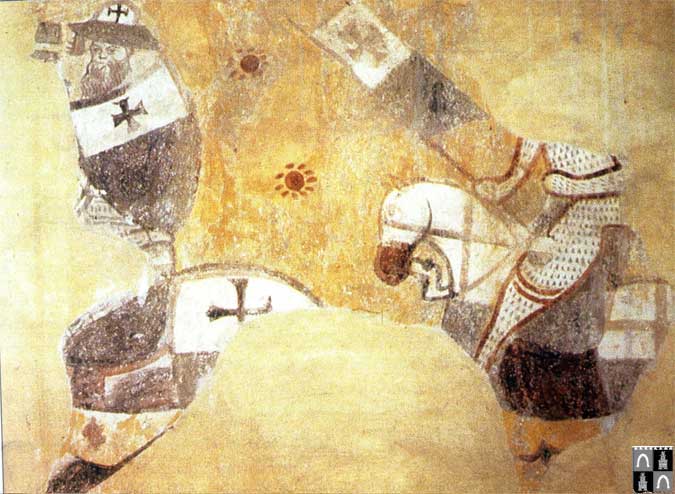|
|
Templar Fresco, Church of San Bevignate, Perugia, Umbria, Central Italy, 13th Century

Picture source
San Bevignate is a church in Perugia, Umbria, central Italy. The church was commissioned by the Templars in substitution of their former church of San Giustino díArna, from which they had been ousted in 1277.
San Bevignate, for whom it is named, was a rather mysterious local hermit who had a notable following among Perugiaís people but was in fact never officially canonized.
The church was built around 1250. In 1312, after the suppression of the Templar Order, it was acquired by the Hospitalliers.
In 1324 Ricco di Corbolo, a rich Perugine merchant, acquired the whole complex and housed there a feminine monastic community.
In 1517 the nuns left the convent, which returned to the Knights of Malta. In 1860 the church was secularized.
The sober interior of the church has great similarities with the chapels built by the Templars in the Holy Land.
It has a single nave with groin-vaulted ceiling.
The square apse, containing typical Templar architectural motifs such as the cosmological cross and stars, is introduced by a large triumphal arch.
Works of art include the Procession of Flagellants, a Battle Between Templars and Muslims, the Legend of San Bevignate and other 13th-century frescoes.
The left figure is referenced on p.29, WAR - 091 - Knight Templar 1120-1312 by Helen Nicholson
The Templarsí view of themselves: this bearded Templar appears in the mid 13th century fresco on the west wall of the Templarsí church of San Bevignate, Perugia, Italy.
He is armed for battle, wearing a chain mail shirt and a broad-brimmed kettle-hat rather than a fully enclosed helmet.
His shield and hat carry a version of the Orderís arms different from that found in the contemporary drawings by the English monk Matthew Paris (see opposite page):
black below, white above, with a black cross on the white section.
Possibly this represents the Masterís arms, while the arms drawn by Matthew Paris were those of the Order as a whole.
The kettle-hat would have offered less protection than a fully enclosed helmet; it would have been cooler in the hot conditions of the Middle East,
yet this Templar wears no covering over his armour, which would have become very warm in the sun.
|
|

